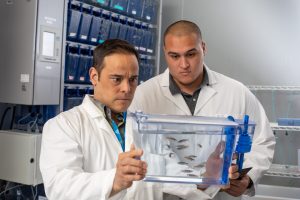Fairness First blog
Researchers voices in health equity
The Fairness First blog represents a space where researchers share with the broader community why health equity research matters to them, how do they connect to health equity, and what is the value of community engagement in the research process.
August 18, 2022
Discovering how organisms interacting with their chemical environments affect health and development with Matt Salanga
Assistant Professor, Department of Biological Sciences

Matt Salanga is an Assistant Professor in Biological Sciences. His research is focused on understanding how organisms interact with their chemical environments in ways that affect development and health.
Q. How would you describe your research and why it matters?
A. My research focuses on understanding how organisms interact with their chemical environments in ways that affect development and health. One key focus is on uranium chemical toxicity mainly because of its regional importance in the Southwest United States.
We use zebrafish as a laboratory test species because their genome* is similar to that of humans and they have semitransparent embryos. These features allow us to directly observe how the organism develops and analyze how the genes function.
*A genome includes all the genetic information (i.e., DNA) needed for an organism – such as a human, a plant, or a virus – to be created and to function.
Q. Tell us about a moment in your life when you decided, “This is the type of research I want to do!”
A. As an undergraduate, I changed majors three times, ultimately deciding on zoology after trying out chemistry and environmental science. That fascination with the natural world made zoology a great fit. But soon I learned that what’s inside an animal can be even more breathtaking than the organism as a whole. Courses in cellular and molecular biology, genetics, and microbiology introduced me to the invisible world of biology, and frankly, I got hooked.
Q. What is the element of “unfairness” or “inequity” in the issue you are examining (in the broad context of health and wellbeing)?
A. Environmental pollutants often have an excessive or uneven effect on the health of underserved communities. There are more than 500 abandoned uranium mines on the Navajo Nation. These mines continue to release uranium into the environment and contaminate water and agricultural resources the Navajo people rely on.
 Q. Based on your previous answer, how do you see your work helping to push the needle on this issue toward “fairness” or “equity”?
Q. Based on your previous answer, how do you see your work helping to push the needle on this issue toward “fairness” or “equity”?
A. Controlled lab studies are a crucial tool for determining the effects of chemicals on life. Focusing my research on uranium and arsenic can improve our understanding of what these chemicals are capable of. This work may yield reliable scientific data to inform regulatory agencies, who enforce laws, and provide the grounds for change.
Q. How do you want your research to make a difference or change in this world?
A. Efforts to contain abandoned uranium mines are ongoing but incomplete. At the same time, some parties would like to see mining activities resume. Research in my lab can shed new light on the dangers of uranium exposure. This knowledge can inform policymakers and drive big picture institutional change to protect those that live and rely on the natural resources surrounding these mining areas.
Q. What is one important lesson you’ve learned about yourself and this region through your research?
A. Many of the challenges faced by our tribal neighbors were unknown to me before launching my research program at NAU. For example, many homes in the Navajo Nation rely on wells for accessing groundwater; however, in some cases, the groundwater is contaminated with uranium. And the nearest alternative water supply could be hours away on unpaved roads.
Q. Is there a global context you can apply to your research? How is your research connected to situations/advancements happening on a global scale?
A. Uranium exposure goes beyond the Navajo Nation. People living or working near modern battlefields, like those in the middle east, come across uranium released from armor-penetrating munitions. When one of these weapons hits a hard target, tiny bits or microparticles of uranium and shrapnel spread into the environment. These particles can be inhaled, consumed in contaminated water or food, or even directly lodged in the body due to shrapnel injuries or wound contamination.
You can connect with Dr. Salanga at Matthew.Salanga@nau.edu.
Back to the main Fairness First Campaign page.


